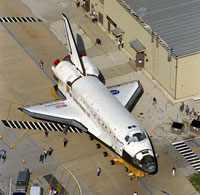Spacemen examine Discovery for cracks
The space shuttle Discovery was carefully inspected by seven astronauts Wednesday to make sure probable cracks under the protective coating had not become worse.

The inspection came on the first full day of what NASA considers to be the most complicated international space station construction mission yet. The shuttle was to reach the station Thursday.
Commander Pamela Melroy and her crew used a laser-tipped inspection boom to check Discovery's wings. The check is standard since a strike by a slab of fuel-tank foam created a hole in Columbia's wing in 2003, downing the shuttle.
But astronauts were going extra slowly so they could more thoroughly check three of 44 wing panels where it is possible there are cracks beneath the coating. NASA said last week that a new inspection method uncovered the possible degradation.
After a lengthy discussion last week, top mission managers deemed Discovery safe for launch even though NASA's own safety group wanted to delay the liftoff to conduct further testing and possibly replace the panels. It is not known whether cracks could worsen and cause the coating to chip off and make the area more vulnerable to the 3,000-degree (1,649 Celsius) heat of re-entry.
During the inspection, the crew also worked to fix a glitch with a high-speed modem that connects the shuttle's computers to Mission Control. NASA officials said the glitch was not affecting the day's work.
At least six pieces of foam insulation came off Discovery's fuel tank during Tuesday's liftoff, but the debris posed no risk to the shuttle because it was shed after the crucial first two minutes, officials said.
"It's preliminary only, but it did look like a clean ascent," Mission Control informed Melroy, who is only the second woman to lead a shuttle crew.
A small piece of foam broke off a bracket on Endeavour's fuel tank during the last launch in August, possibly along with ice, and gouged the shuttle's belly. That led to changes to Discovery's fuel tank to prevent dangerous ice buildup.
NASA engineers will analyze the images gathered during the launch, Wednesday's inspection and photos to be taken Thursday before clearing Discovery for landing.
NASA's space operations chief, Bill Gerstenmaier, said after liftoff that the astronauts face a tremendous series of challenges, but noted, "I can't think of a better start to this mission than what we got today." It was the third on-time shuttle launch in a row.
The shuttle's primary payload is an Italian-built compartment, about the size of a small bus, that will serve as the docking port for science labs due to arrive beginning in December. Italian astronaut Paolo Nespoli is personally delivering the pressurized chamber, called Harmony.
During their 1Ѕ-week station visit, the astronauts must install Harmony, relocate a giant girder and set of solar wings, extend those solar wings and radiators, and test a thermal tile repair kit. Five spacewalks are planned, which will be the most ever conducted while a shuttle is docked at the station.
Astronaut Daniel Tani will move into the station once Discovery docks. He will replace Clayton Anderson, who will return to Earth on the shuttle after five months in space.
Subscribe to Pravda.Ru Telegram channel, Facebook, RSS!


